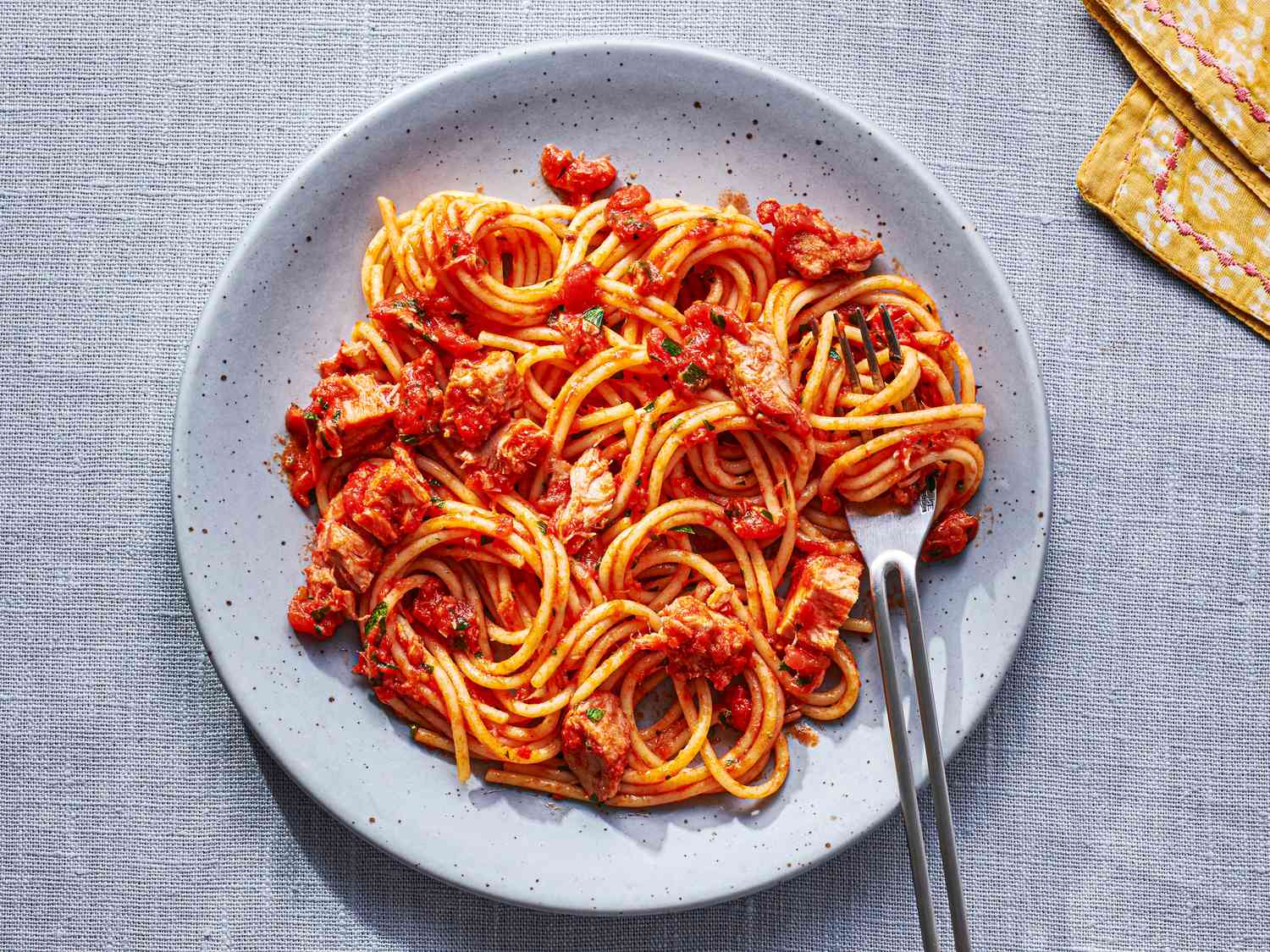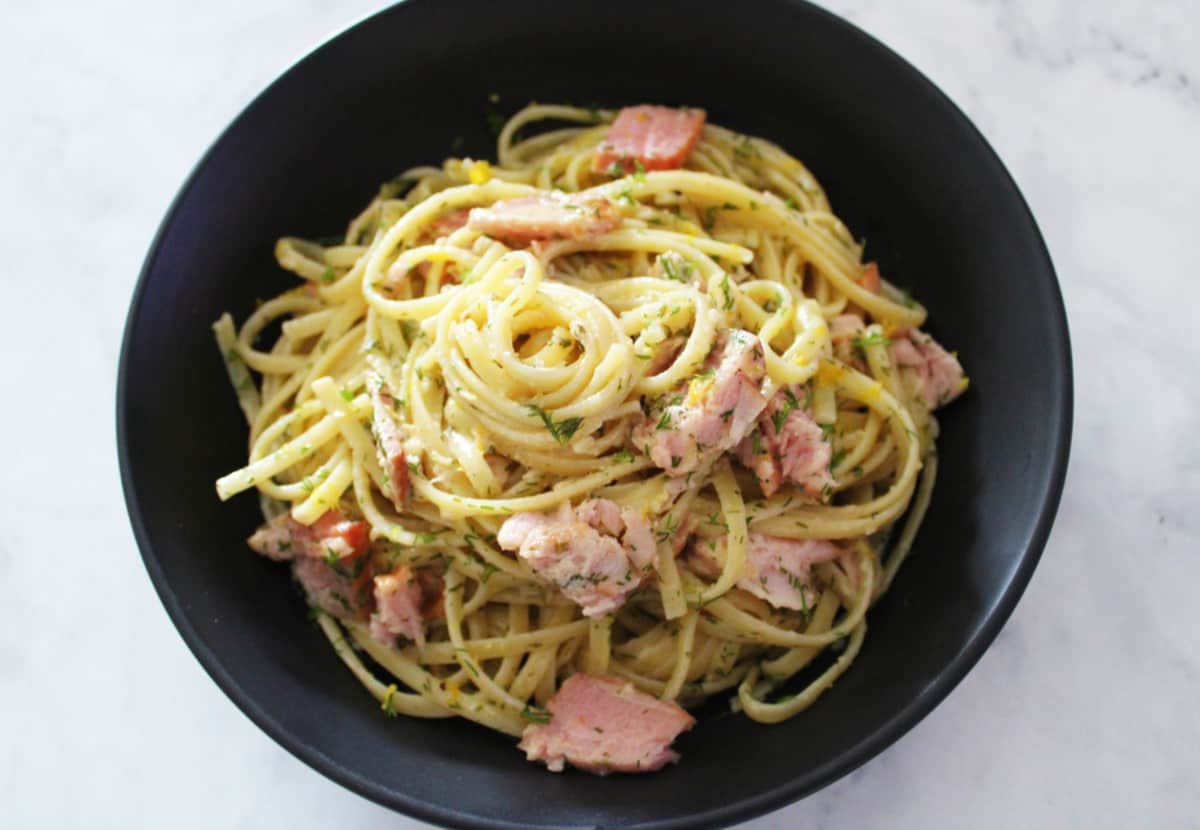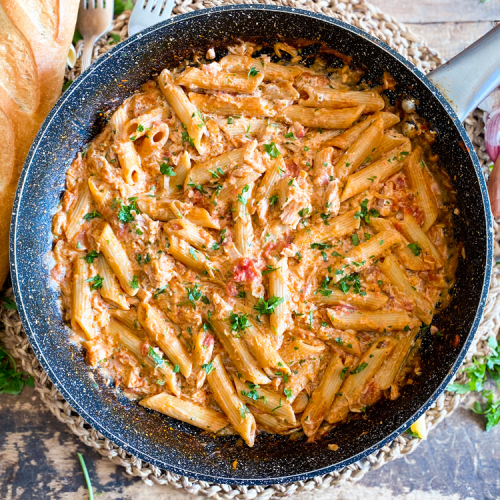Tuna pasta salad is tasty cold or at room temperature. Avoid reheating it. If you prefer it less chilly, let it sit for a while after taking it out of the fridge to reach room temperature. Further, it depends on your preference. Both preparations have their own unique flavors and characteristics.
So let’s get started on the quest to learn more.
Distinguishing Characteristics of Hot and Cold Tuna Pasta
| Hot Tuna Pasta | Cold Tuna Pasta |
| Served hot right after cooking | Served chilled, ideal for warm days |
| Comforting and hearty, great for cooler days | Light and refreshing, a no-cook summer favorite |
| Heat melds flavors, intense ingredients | Chilled temperature enhances ingredient freshness |
| Customizable sauce and seasonings | Vinaigrette or mayonnaise-based dressing options |
| Cheese can melt for rich creaminess | Tangy and zesty flavors in a cool pasta salad |
| Perfect for picnics, potlucks, and make-ahead prep |
| Common Name | Scientific Name |
| Albacore | Thunnus alalunga |
| Bigeye Tuna | Thunnus obesus |
| Blackfin Tuna | Thunnus atlanticus |
| Northern Bluefin Tuna | Thunnus thynnus |
| Yellowfin Tuna | Thunnus albacares |
| Southern Bluefin Tuna | Thunnus maccoyii |
| Skipjack | Katsuwonus pelamis |
| Longtail Tuna | Thunnus tonggol |
Navigating the Choice of Hot or Cold Tuna Pasta
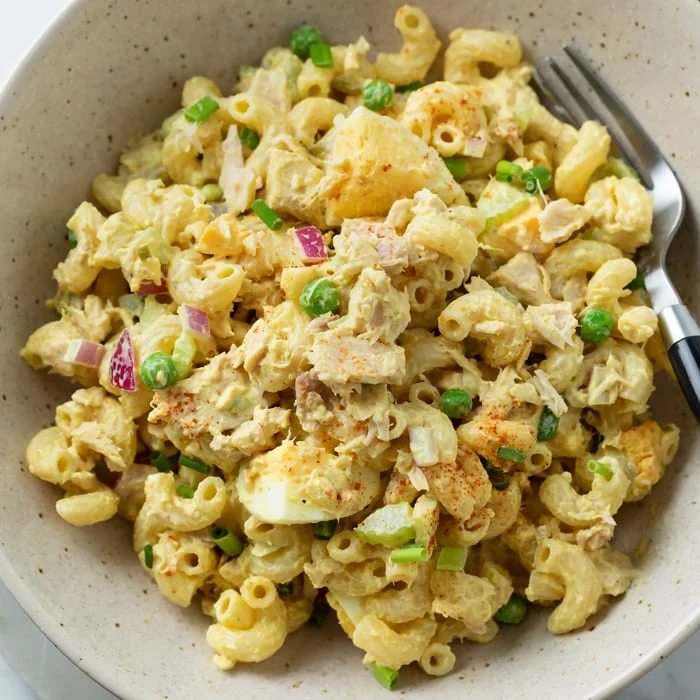
Weather and Season:
In scorching summer or under the sweltering heat of tropical climates, cold tuna pasta emerges as the quintessential choice, providing a refreshing respite and refraining from adding any unnecessary warmth to the body.
Conversely, when the mercury drops and frosty winds sweep through colder seasons or regions, the warm embrace of hot tuna pasta offers comfort and solace.
Personal Taste and Preferences:
In addition, individual predilections and taste proclivities wield substantial influence in this culinary debate. Some individuals gravitate towards the sensuous allure of hot pasta, relishing its amalgamation of flavors and textures, while others find themselves drawn to the crisp and airy qualities of its cold counterpart. Taste it appears is a compass guiding this gastronomic journey.
Portability and Convenience:
Moreover, The call for ease of transport and dining on the move beckons consideration. The inherent portability of cold tuna pasta bestows it with the coveted title of picnic champion and the perfect companion for packed lunches.
In contrast, the hot counterpart often requires an on-the-spot preparation, best enjoyed fresh from the stove in the comfort of one’s abode.
Occasion and Setting:
The setting and occasion cast a discerning eye over this gastronomic duel. While the grandeur of a formal dinner may befit a hot one, the casual nonchalance of an outdoor gathering finds its kindred spirit in the cool composure of the cold variant.
The choice reflects not only the season but also the ambiance and conviviality of the event.
Nutritional Considerations:
In the quest for health and nutrition, the choice of pasta preparation method holds weight. Some discerning individuals lean towards hot pasta, believing it retains essential nutrients, while others look to the cold rendition, attributing it to health virtues that align with their dietary goals.
The question of nutrition weaves a thread through this culinary tapestry.
Ingredients and Toppings:
The array of ingredients and toppings further bifurcates this culinary journey. Cheese-laden or cream-based concoctions may find their natural habitat in the hot version, where their rich textures meld seamlessly.
On the other hand, a cold one becomes the canvas for fresh herbs and crisp vegetables, painting a picture of vibrancy and lightness.
Preparation Time:
In the relentless march of time, the available minutes weigh upon the decision-making process. Cold tuna pasta, with its swift and minimalistic preparation, appeals to those seeking expedience.
Meanwhile, hot pasta, simmering patiently on the stove, asks for a more substantial investment of time and anticipation.
Adaptability and Creativity:
The canvas of culinary experimentation and creativity beckons to some. Here, the ebb and flow of moods, the availability of ingredients, and the longing for a unique dish guide the choice.
The beauty of adaptability lies in its capacity to cater to the ever-evolving palate.
Health and Dietary Goals:
At last, For the health-conscious, the compass often points toward specific dietary goals. Those on a quest for reduced calorie intake may find solace in the fresh, crisp attributes of cold pasta.
Simultaneously, the pursuit of protein-rich sustenance elevates the appeal of hot pasta, where the virtues of cooked fish meet the demands of a discerning diet.
Crafting a Flavorful Homemade Tuna Pasta: Step-by-Step
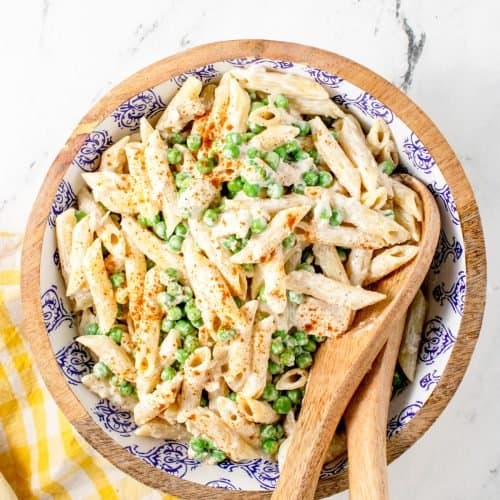
Ingredients
- Olive oil
- Onions (or green onions)
- Salt
- 1/2 can of tuna
- 1/2 can of sweet corn
- Pasta
- Mayonnaise
- Black pepper (optional)
- Water
Step-by-Step Process
- Begin by heating 1 tablespoon of olive oil in a frying pan over medium heat, allowing it to reach the desired temperature.
- Add finely chopped onions or green onions to the heated oil and sauté them lightly for added flavor.
- Season the sautéed onions with a pinch of salt to enhance the taste.
- Introduce 1/2 a can of tuna and slightly less than 1/2 a can of sweetcorn to the pan, infusing your dish with a delightful combination of flavors and textures.
- Allow this mixture to lightly fry for approximately 30 seconds, ensuring that the ingredients meld together harmoniously.
- In a separate pot, follow the instructions on the pasta package to boil it to perfection.
- Once your pasta reaches the desired tenderness, drain it using a colander and let it sit to ensure all excess water is removed.
- Return the drained pasta to the pot.
- Carefully combine the tuna and sweetcorn mixture with the pasta, ensuring an even coating of the sauce.
- Integrate 2 generous tablespoons of mayonnaise into the mix, ensuring it binds all the components together seamlessly.
- To complete your dish, season it with a dash of salt and, if desired, a hint of black pepper for an added layer of flavor.
Delicious Tuna Pasta Salad Variations to Elevate Your Dish
Enhance Creaminess: Infuse it with extra richness by incorporating diced cheddar cheese. Its creamy, sharp profile beautifully complements the other flavors.
Lighten with Yogurt: For a healthier twist, swap out half of the mayonnaise with luscious plain Greek yogurt. This not only reduces the calorie count but also imparts a pleasantly tangy undertone.
Milder Onions: If you prefer a gentler onion essence, replace regular onions with finely chopped shallots. Their subtle, sweet flavor won’t overwhelm the dish.
Textural Delight: Add a generous handful of diced celery to infuse it with a delightful crunch, providing a refreshing contrast to the pasta and tuna.
Protein Boost: Incorporate diced hard-boiled eggs for an economical and protein-rich enhancement. Their velvety texture and mild taste meld harmoniously with the other ingredients.
Flavorful Relish: A few tablespoons of dill or sweet relish introduce a burst of complexity and tang to your salad, enhancing the overall flavor profile.
Go Beyond Tuna: Experiment with the sea’s bounty by substituting canned salmon for tuna. Its distinct taste and flaky texture create an entirely new gustatory experience.
Herbaceous Elegance: Elevate your creation with a medley of fresh herbs, such as dill, parsley, tarragon, or green onions. These herbs infuse it with a burst of green, fragrant goodness, transforming it into a symphony of flavors.
Tuna Pasta Variations
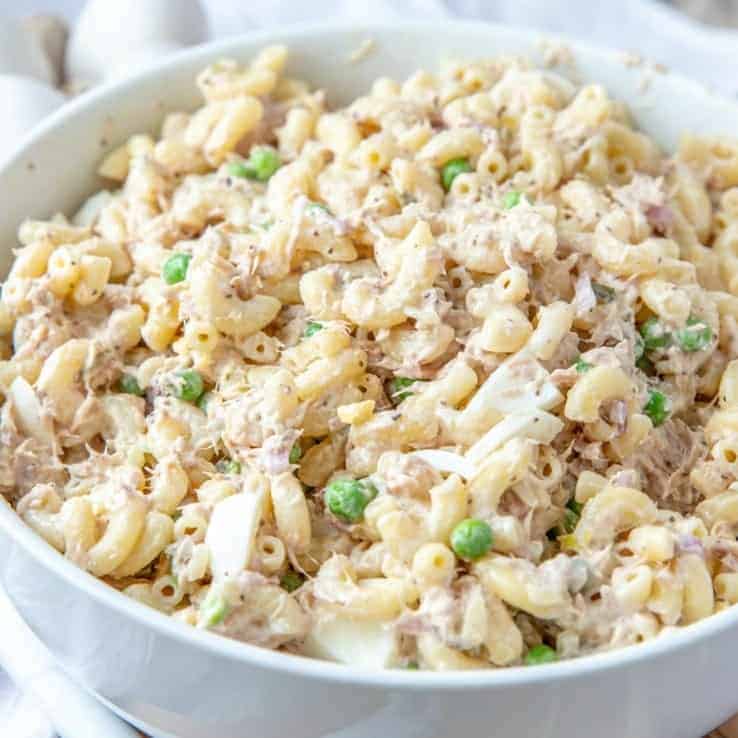
Tuna Alfredo:
- Combine it, with cooked pasta, and a rich Alfredo sauce made with heavy cream, butter, and Parmesan cheese for a creamy and indulgent variation.
Tuna Pesto Pasta:
- Toss cooked pasta with a vibrant pesto sauce, tuna, and cherry tomatoes for a fresh and flavorful variation.
Tuna Carbonara:
- Mix it with a classic carbonara sauce made from eggs, grated Pecorino Romano cheese, pancetta or bacon, and black pepper for a rich and savory pasta.
Tuna Primavera:
- Combine it with a medley of sautéed or roasted seasonal vegetables like bell peppers, zucchini, and cherry tomatoes for a colorful and nutritious variation.
Spicy Tuna Pasta:
- Add chili flakes or hot sauce to your tuna pasta for a spicy kick, along with ingredients like garlic and sun-dried tomatoes for extra flavor.
Tuna and Lemon Pasta:
- Toss it with cooked pasta, lemon zest, lemon juice, and fresh herbs like parsley for a bright and zesty flavor profile.
Tuna and Spinach Pasta:
- Incorporate fresh or sautéed spinach into your tuna pasta for added greens and nutrients.
Tuna and Mushroom Pasta:
- Combine it with sautéed mushrooms and a creamy sauce for a hearty and earthy twist on the dish.
Tuna and Artichoke Pasta:
- Pair it with marinated artichoke hearts, Kalamata olives, and a light vinaigrette for a Mediterranean-inspired variation.
Tuna and Capers Pasta:
- Enhance the flavor of it with the briny, salty taste of capers, along with lemon and a touch of white wine.
Tuna and Sweet Pea Pasta:
- Add sweet peas and a white wine or lemon butter sauce to your tuna pasta for a delightful blend of flavors.
Tuna and Sun-Dried Tomato Pasta:
- Mix tuna with sun-dried tomatoes, garlic, and a light olive oil-based sauce for a sweet and savory combination.
Tuna and Broccoli Pasta:
- Incorporate steamed or blanched broccoli florets into your tuna pasta for added texture and nutrients.
Tuna and Cilantro-Lime Pasta:
- Give your tuna pasta a Mexican-inspired twist by adding cilantro, lime juice, and a touch of cumin for a burst of fresh flavors.
Tuna and Curry Pasta:
- Create a curry-infused sauce with coconut milk and your favorite curry spices to pair with tuna for a fusion of flavors.
FAQs
Is tuna best hot or cold?
Tuna can be enjoyed both hot and cold, depending on personal preference and the dish you’re preparing.
Is tuna salad served hot or cold?
Tuna salad is typically served cold, as a chilled and refreshing dish.
Can you eat tuna cold?
Yes, you can eat tuna cold, such as in sandwiches or salads.
Can you eat warm tuna pasta?
Yes, you can eat warm tuna pasta, especially if it’s been prepared as a hot dish.
Can tuna be served hot?
Yes, tuna can be served hot in various dishes like casseroles, stir-fries, or grilled preparations.
Final Words
Whether tuna pasta is best served hot or cold ultimately depends on personal preference and the occasion. Hot tuna pasta offers a comforting, hearty meal, ideal for cooler days, and allows flavors to meld together, while cold tuna pasta is a refreshing and convenient choice, perfect for warm days or as a pasta salad.
Additionally, both variations offer unique flavor profiles, and the decision between them should be based on your individual taste and the specific context in which you plan to enjoy this versatile dish.





